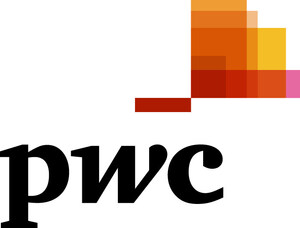NEW YORK, June 14, 2011 /PRNewswire/ -- As we move into the golden age of the empowered consumer, the demand for digital experiences is increasing and becoming the norm, according to PwC's Global entertainment and media outlook: 2011-2015 (Outlook) – the most comprehensive five-year outlook for global consumer spending and advertising revenues directly related to entertainment and media content – released today. The report finds that digital is acknowledged as the central driver of future operating models, consumer relationships and revenue growth. Emerging out of recession and into recovery in 2010, the Outlook forecasts that global entertainment and media (E&M) spending is expected to rise from $1.4 trillion in 2010 to $1.9 trillion by 2015, growing at a compound annual growth rate (CAGR) of 5.7 percent. The U.S. E&M market is expected to grow at 4.6 percent CAGR reaching $555 billion in 2015, from $443 billion in 2010.
(Logo: http://photos.prnewswire.com/prnh/20100917/NY66894LOGO)
According to the Outlook, the entire E&M industry is being driven to create experiences that engage today's empowered consumer by redesigning the content experience to be multi-purpose and multi-platform which, in turn, creates multiple opportunities for monetization.
"Triggered in large part by the device revolution, the consumer migration to digital has continued at an even faster pace and at the same time advertisers are responding by seeking a greater involvement with the consumer's media and entertainment experience," said Ken Sharkey, entertainment, media & communications US practice leader, PwC. "The biggest challenge for E&M companies is to turn five key attributes that matter to consumers – convenience, experience, quality, participation and privilege – into sustainable, profitable and engaged relationships by offering advantages that outweigh the attractiveness of free or pirated content."
While digital currently accounts for just over a quarter of total industry revenues, it is expected to account for 58.7 percent of all growth in spending during the next five years, globally. Digital spending in the U.S. is expected to account for 28.5 percent of all E&M spending in 2015, up from 20.6 percent in 2010.
Advertising rebounds with largest year-on-year swing
Advertising, the most cyclically sensitive of the three E&M spending streams (advertising, consumer and end-user spending), recorded the largest year-on-year swing, rebounding in the U.S. at 5.4 percent in 2010 from a 14.4 percent slump in 2009. Overall, U.S. advertising is expected to increase at a 4.2 percent CAGR from $170 billion in 2010 to $208 billion in 2015. Internet advertising is expected to average 12.2 percent CAGR, while video games and cinema advertising, the two smallest segments, are expected to grow by 8.0 percent and 6.7 percent CAGR, respectively. Television advertising, the largest segment, is expected to grow at 4.9 percent CAGR. Directories (-1.8 percent) and newspaper advertising (-0.2 percent) are expected to be the only categories to decline.
According to the Outlook, as content providers leverage creative thinking and innovation to drive digital revenues, advertisers and agencies are becoming increasingly sophisticated in identifying and creating new brand opportunities and ways to engage with consumers on digital content services and platforms – and they're listening and engaging directly with consumers to a greater extent. These new approaches are aiding the unexpected strong recovery in advertising and restoring the attractiveness of advertising-funded models, which are often blended with a subscription model.
Rise of the Collaborative Digital Enterprise
Digitization is opening up major opportunities for new types of services, business models, collaborative partnerships and consumer relationships across the E&M industry. Advances in all these areas are emerging daily on the back of the ongoing flood of innovation in devices, delivery methods and pricing.
This is leading towards a new operating model specifically designed for the digital ecosystem – the Collaborative Digital Enterprise (CDE) – an enterprise which is technology driven and dynamic, interconnected and continuously engaged with its entire customer, employee and supplier ecosystem.
According to PwC, a collaborative digital enterprise needs to embrace three industry-wide dynamics to achieve success in the emerging digital environment:
- Digital: the rapid and accelerating digitization of elements including content, business processes, and product innovation. Social media, mobility and the explosion of apps have already had profound impacts which will continue to grow.
- Demand: Consumers are empowered, connected, able to influence large communities of people, and ready to play an increasingly collaborative role in developing new E&M products and services.
- Data: the proliferation of digitized content, web access and social media means companies have the ability to mine and analyze detailed/contextual information which hasn't previously been available. Data is key to the interface between consumers, content experience and brand as well as to innovation.
"The year 2011 has experienced a surge in collaborative partnering spurring the transformation of the E&M industry over the next five years into a digital collaborative ecosystem. This model is expected to emerge as the template of success and by 2015, most E&M companies and the vast majority of the winners will have digital collaboration infused into their DNA. The real question, then, is how quickly it comes about," added Sharkey.
U.S. segment highlights
In the U.S., Internet access and Internet advertising is expected to continue to outperform the other E&M segments, with 7.8 percent and 12.2 percent CAGR, respectively. TV subscriptions (5.6 percent CAGR), filmed entertainment (5.4 percent CAGR), and out-of-home advertising (5.4 percent CAGR) are set to grow more than 5 percent compounded annually. TV advertising (4.9 percent CAGR), video games (4.6 percent CAGR), business-to-business publishing (4.1 percent CAGR), consumer magazine publishing (3.5 percent CAGR), radio (3.5 percent CAGR) and consumer and educational book publishing (2.1 percent CAGR) are expected to generate modest growth. Spending on recorded music (-0.4 percent CAGR) and newspaper publishing (-0.4 percent CAGR), and are expected to each be lower in 2015 than in 2010. Overall, U.S. consumer/end-user spending is expected to grow by 4.3 percent CAGR.
About the Outlook
PwC's Global Entertainment & Media Outlook 2011-2015, the 12th annual edition, contains in-depth analyses and forecasts of 13 major industry segments across four global regions: North America (USA, Canada), EMEA (Europe, Middle East, Africa), Asia Pacific and Latin America. The Outlook offers a five-year outlook for global consumer spending and advertising revenues directly related to entertainment and media content, along with insights into the technology, government, political, and business trends driving those forecasts. To order online access, visit: http://www.pwc.com/outlook.
Digital Spending
Digital spending, as included in the Outlook, consists of broadband and mobile Internet access, online and mobile Internet advertising, video-on-demand, mobile TV subscriptions, digital music, electronic home video, online and wireless video games, digital consumer magazine circulation spending, digital newspaper circulation spending, digital trade magazine circulation spending, electronic consumer, educational and professional books, and satellite radio subscriptions.
About the PwC Network
PwC firms provide industry-focused assurance, tax and advisory services to enhance value for their clients. More than 161,000 people in 154 countries in firms across the PwC network share their thinking, experience and solutions to develop fresh perspectives and practical advice. See www.pwc.com for more information.
© 2011 PwC. All rights reserved. "PwC" and "PwC US" refer to PricewaterhouseCoopers LLP, a Delaware limited liability partnership, which is a member firm of PricewaterhouseCoopers International Limited, each member firm of which is a separate legal entity. This document is for general information purposes only, and should not be used as a substitute for consultation with professional advisors.
SOURCE PwC
WANT YOUR COMPANY'S NEWS FEATURED ON PRNEWSWIRE.COM?
Newsrooms &
Influencers
Digital Media
Outlets
Journalists
Opted In




Share this article